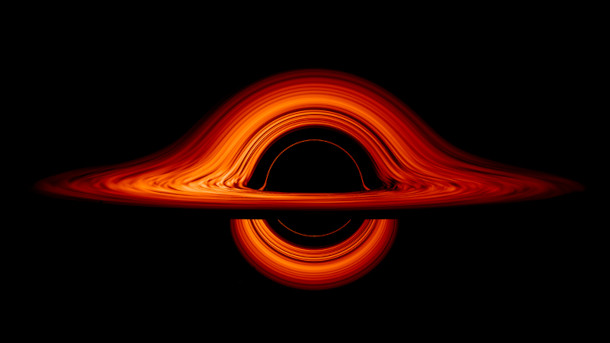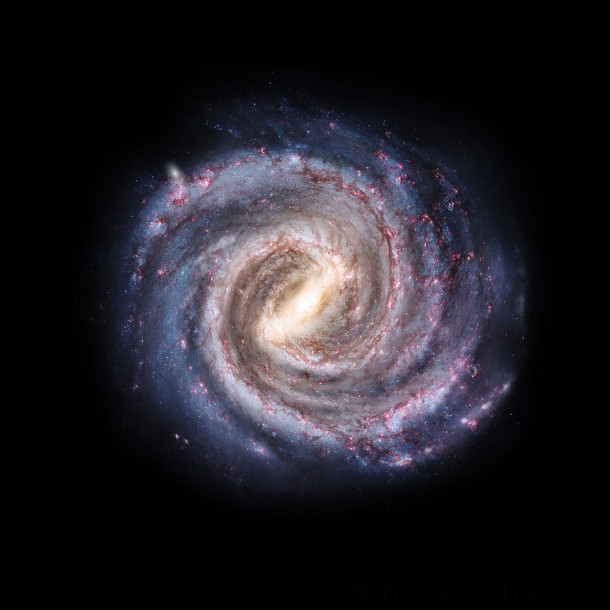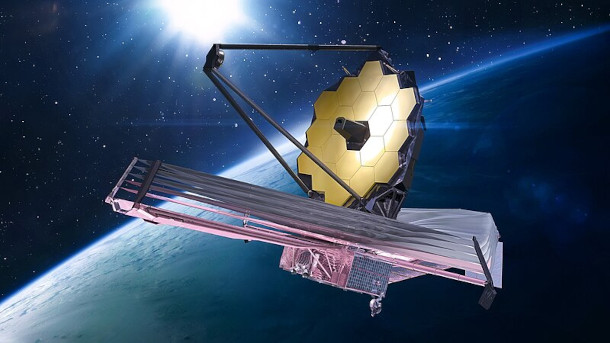Black Hole Breakthrough
Air Date: Week of March 29, 2024

Image depicting an accretion disc around a black hole. Although light cannot escape a black hole, scientists are able to observe the bright, hot gas swirling around it. (Photo: NASA’s Goddard Space Flight Center/Jeremy Schnittman, cmglee, Wikimedia Commons, CC BY-SA 4.0)
An international team of astronomers recently reported the discovery of a 13 billion-year-old black hole, to date the oldest ever observed, thanks to the powerful James Webb Space Telescope. Lead author Dr. Roberto Maiolino joins Host Jenni Doering to explore new questions about how these mysterious, extremely dense objects form and grow.
Transcript
DOERING: At the heart of many large galaxies are enormous black holes, objects so mysterious that cosmologists are largely in the dark about them. Black holes are regions of space so dense that even light can’t escape their powerful gravity, making them extremely difficult to observe. Now the James Webb Space Telescope, in operation since 2022, is giving us clues that could help reveal the secrets of black holes. Using its data, an international team of astronomers recently reported the discovery of the oldest black hole ever observed, dating to more than 13 billion years ago. That’s only 400 million years after the Big Bang, a blink of an eye on astronomical timescales. The findings of the study, published in the journal Nature, suggest that early black holes may have formed differently and grown much more quickly than previously thought. Here to discuss is the lead author of the study, Dr. Roberto Maiolino, Professor of Experimental Astrophysics at the University of Cambridge. Welcome to Living on Earth!
MAIOLINO: Hello, thank you for inviting me.
DOERING: So take us to class for a brief moment. What exactly is a black hole?
MAIOLINO: So a black hole is a region of space where the pull of gravity is so strong that not even light can escape. And typically, we group black holes in two main classes, black holes resulting from the collapse of massive stars—these are called stellar black holes—and so-called supermassive black holes, which can have masses of a million to billions of times the mass of the Sun, which are located in the center of most galaxies, and how they have formed is debated. Certain they have been accreting gas from the host galaxy, but their origin is still a matter of debate.
DOERING: So how big is this black hole that you've discovered? And what does this tell us about black holes and the universe that we didn't know before?

An artist’s depiction of the Milky Way galaxy. The distant black hole discovered by Maiolino and others is about the same size as the one at the center of the Milky Way, but the fact that it achieved such large mass so soon after the Big Bang suggests that black holes may be able to grow more quickly than previously thought possible. (Photo: Pablo Carlos Budassi, Wikimedia Commons, CC BY-SA 4.0)
MAIOLINO: Well, is not particularly big, in the sense that it's of the order of a few million times the mass of the Sun. The black hole at the center of our Milky Way is similar, is about 4 million times the mass of the Sun. However, what makes this black hole particularly exciting is that it has reached such high mass very early in the Universe. We are observing it at an epoch when the Universe was only about 400 million years old, about 13.3 billion years ago. So actually, very soon after the Big Bang. The standard scenarios that were accepted until recently about the formation of these early massive black holes was that they would form out of the relatively light black hole seed, formed out of the remnants of massive stars, and then accrete and grow by eating gas from the host galaxy. But there is a limit at which these black holes could grow according to theory. And with this scenario, essentially, is nearly impossible to make such massive black holes so early in the Universe.
DOERING: So how do you explain this discrepancy?
MAIOLINO: Is not simple. Astronomers had to come up with alternative theories. One possibility is that black holes were born big. There is indeed a theory that in the early Universe, primordial clouds of pristine gas made of helium and hydrogen, under certain conditions would collapse to form an already very massive black hole. If black holes were born so big, then it takes not that much effort, let's say, to grow to the size that we see in this system. Alternatively, black holes could actually originate from stellar remnants—so the collapse of the first generation of stars—but then may have grown much more quickly, either by merging with other black holes, or by gobbling matter much more rapidly than we thought it was possible. So currently, we can't distinguish clearly between these two scenarios. However, this black hole is seen to actually being quite greedy. It's accreting matter indeed at a very high rate. And therefore, it makes us think that the scenario in which this has grown by accreting a lot of matter very quickly could actually be a real possibility.

An artist’s rendering of the James Webb Space Telescope (JWST) above the Earth. The large mirrors on the telescope help it to collect light even from the distant reaches of the Universe. (Photo: NASA/dima_zel, Wikimedia Commons, CC BY 4.0)
DOERING: So black holes are called that because, well, they're black. Light can't escape from them. So how can we actually see or identify one?
MAIOLINO: Yeah, indeed, we don't see directly the black hole. By definition, the black hole doesn't emit light. But what we see is the glow of the gas swirling around the black hole, which becomes indeed very hot, and can radiate a lot in the ultraviolet. We also see the gas which is being illuminated by such energetic radiation. And typically, this results in very dense gas, which is seen around these supermassive black holes, and also very highly ionized gas, that is gas in which the atoms have been stripped of many of their electrons. And so this is a typical signature of gas surrounding a black hole.
DOERING: Now, I understand that you were able to discover this black hole using data collected by the James Webb Space Telescope, which was launched in December 2021. And I don't think it's a stretch to call JWST one of the great achievements of our time. How did the telescope make this discovery possible?
MAIOLINO: These galaxies was already peculiar because it has an exceptionally high luminosity. So there was already the suspicion that the light that we see from these galaxies would not be coming simply by stars, but there might be something more, such as accretion onto a supermassive black hole. The main problem, actually, is that despite being intrinsically luminous, being so far away it becomes very weak, because it has to travel so much throughout the universe. And that's where the James Webb Space Telescope essentially made this possible. Because it's being the largest telescope in space, with its very large mirror, it can actually collect enough light, even from the most distant part of the Universe, to make the light and the signature of these processes detectable with its instrumentation. It has several fantastic features. But what makes Webb really unique is its sensitivity. It observe primarily in the infrared. And in this band, its sensitivity is orders of magnitude better than any previous facility. Just to give you an idea of the magnitude of the leap, it is equivalent in the visible as suddenly upgrading Galileo's telescope to the modern large telescopes, compressing 400 years of discoveries in the 10, 20 years of operation of James Webb. So we are really making a gigantic leap in the discovery space and in our understanding of the universe.

Roberto Maiolino is professor of Experimental Astrophysics at the Cavendish Laboratory (Department of Physics) and at the Kavli Institute for Cosmology of the University of Cambridge. (Photo: Courtesy of Roberto Maiolino)
DOERING: So what's been the most surprising part of telling this story to all these journalists you've been talking with?
MAIOLINO: Well, the most fascinating thing, I think, not only to journalists, but to myself as well, I would say, is the fantastic new golden period that we are living in astronomy thanks to Webb. My career is 20, 30 years long. And I have never experienced such an excitement, because really, Webb is completely revolutionizing several areas of astrophysics. You know, before Webb, my colleagues were saying, maybe the Universe is not so exciting, is just a extension of what we know, but actually, what we're seeing with Webb in this new domain is actually mostly unexpected and completely new. So it's a totally new endeavor, and totally new excitement in making these new discoveries and new findings. And many of these, we still are struggling to understand. And that's also the fascinating part, because if we understood everything, that would be quite disappointing. Instead, Webb is explaining many things, but also is opening extremely interesting new questions that we want to answer and tackle in the coming years with more observations.
DOERING: Before you go, you know, it's obvious that this is scientifically fascinating. But why is it important for humanity to be able to learn more about the universe that we live in?
MAIOLINO: That's a big question. I think is part of the human spirit to understand more of the universe in which we live, and the nature of the everything. I mean, of course, the discovery of Galileo the sun was not orbiting around the Earth but other way around, of course, didn't change the life of the individuals on Earth, but was in the end mind blowing, because it changed the perspective of humanity, of where we are and what we are and our place in the universe.
DOERING: Roberto Maiolino is a professor of experimental astrophysics at the University of Cambridge. Thank you so much.
MAIOLINO: Thank you so much. Bye bye.
Links
Read the University of Cambridge announcement of the discovery
View a gallery of images from the James Webb Space Telescope
Living on Earth wants to hear from you!
Living on Earth
62 Calef Highway, Suite 212
Lee, NH 03861
Telephone: 617-287-4121
E-mail: comments@loe.org
Newsletter [Click here]
Donate to Living on Earth!
Living on Earth is an independent media program and relies entirely on contributions from listeners and institutions supporting public service. Please donate now to preserve an independent environmental voice.
NewsletterLiving on Earth offers a weekly delivery of the show's rundown to your mailbox. Sign up for our newsletter today!
 Sailors For The Sea: Be the change you want to sea.
Sailors For The Sea: Be the change you want to sea.
 The Grantham Foundation for the Protection of the Environment: Committed to protecting and improving the health of the global environment.
The Grantham Foundation for the Protection of the Environment: Committed to protecting and improving the health of the global environment.
 Contribute to Living on Earth and receive, as our gift to you, an archival print of one of Mark Seth Lender's extraordinary wildlife photographs. Follow the link to see Mark's current collection of photographs.
Contribute to Living on Earth and receive, as our gift to you, an archival print of one of Mark Seth Lender's extraordinary wildlife photographs. Follow the link to see Mark's current collection of photographs.
 Buy a signed copy of Mark Seth Lender's book Smeagull the Seagull & support Living on Earth
Buy a signed copy of Mark Seth Lender's book Smeagull the Seagull & support Living on Earth

